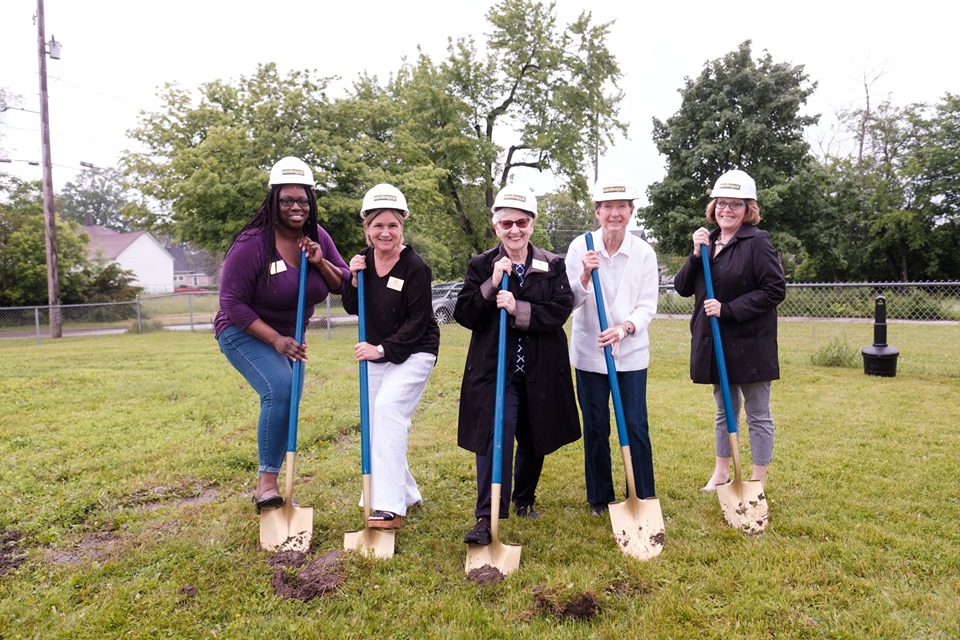As the saying goes, there’s no place like home! This is especially true for the women at Saginaw’s Mustard Seed, who form true family bonds during their 3-6 month stay at this safe refuge. It is also true for those in the community–donors, businesses, churches–even an SVSU fraternity–who have become part of the extended Mustard Seed family over the years.
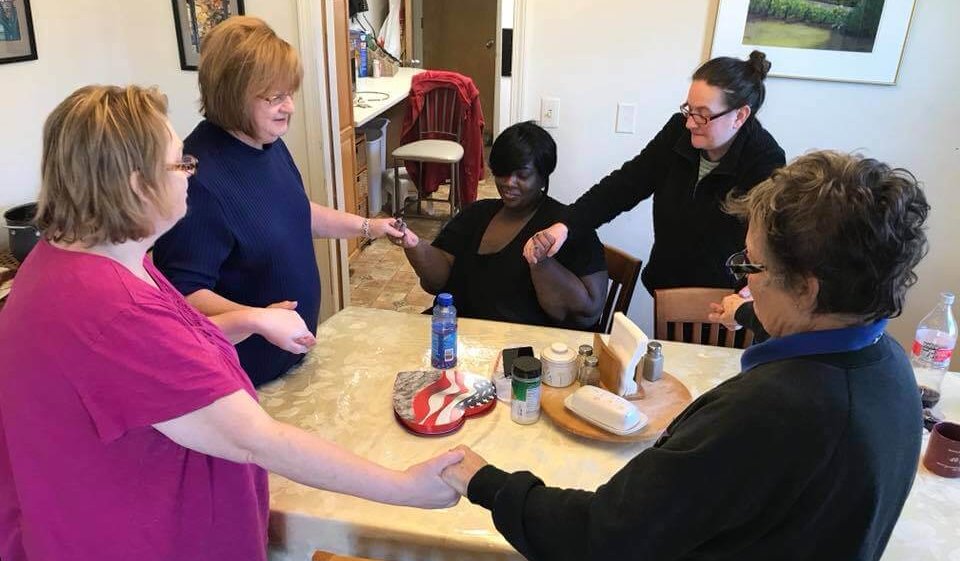
The place
The shelter itself feels like home. Approaching Mustard Seed from the outside, I can’t help but notice the well-groomed yard with a fenced playground for the children, who also live in the shelter with their mothers. The two-story brick home, the former Sacred Heart rectory, is large and solidly built. The driveway, located on the south side of the home, opens up to multiple parking spaces in the rear of the home.
Entering the home through the back entrance, I am personally greeted at the door by Amy Bartels Roe, Mustard Seed Director, who warmly welcomes me with a hug and a smile. As she leads me up a short staircase and into the house, she points out the kitchen on the left, and the large dining area just beyond that. Smells of home-cooking fill the air, and I hear the hum of voices coming from somewhere close by.
Passing the kitchen, I find myself in a long hallway, lined with tables and benches which hold multiple personal possessions and display pictures and small lamps. Turning to the right, I enter the gathering place, the heart of the home, which stretches from the front of the house to the back and is lined with windows. On the walls are framed color portraits of Mustard Seed family members, proud and happy women, some with smiling children. One side of this large comfortable room contains built-in bookcases, a round wooden table and chairs, and an artificial Christmas tree resting on the floor, waiting to be set upright and decorated. The other end of the room is filled with houseplants, lamps, end tables, and oversized sofas and chairs placed strategically around a big coffee table.
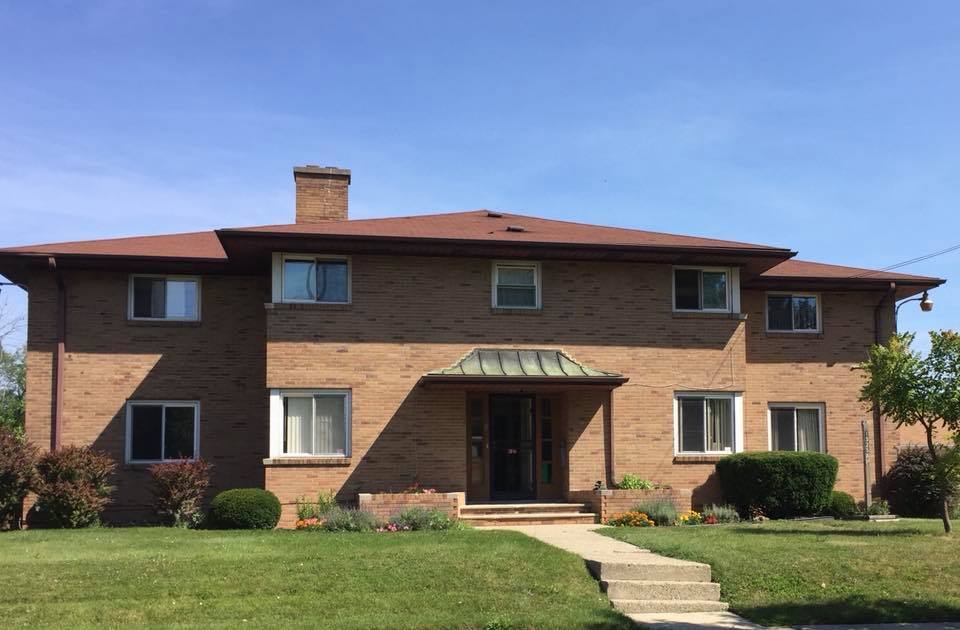
The people
Seated across from each around the coffee table are four of the women who live at Mustard Seed: Tiffany, Shaniqua, Irene, and Susan. They are engaged in dialogue, but quickly break off when Amy enters the room and introduces a guest. Soon we are all seated, and Amy invites the women to tell their stories. There is a little reticence at first, but then Tiffany volunteers to go first. The others follow. Listening to these women pour their hearts out, my own heart aches for their pain and suffering. I can’t help but wonder how many painful, joyful, and heart-felt personal stories have been told by the more than 1,000 women who have lived in this house since its founding 23 years ago, in 1995.
Tiffany, a twenty-five year recovering addict, tells her story of how many times she tried to quit before she came to Mustard Seed. Five months ago, she said, she got down on her knees, asking for God’s help–and Amy and Mustard Seed answered her prayers. Finally, after looking for help all over the country, she is drug free and determined to succeed.
Tiffany explains that there were so many basic things she had to learn at Mustard Seed, things as simple as sitting down to dinner together with family at 5:00 each evening and giving thanks. Along with that, she learned you have to plan, prepare and work to have a meal ready at five. “I never did that as a child. There were no family meals. Now I give back by cooking for others in the house,” she says. She also learned about house rules: No alcohol or drugs are tolerated, and each woman must commit to counseling, treatment, and education. As she talks, Tiffany looks across the coffee table and addresses her now close friend and roommate, Shaniqua, telling her how important it has been to have her there, just to listen. As she tells her story of being enslaved by drugs and her daily war to stop using, she drapes her arm around Amy. Looking into her eyes, she says, “I needed a higher power to help me stay clean. Mustard Seed is helping me because I am helping myself. And you and your staff keep Mustard Seed going and expanding.”
Amy breaks in at this point to tell us that Mustard Seed has a services coordinator, Jane Sills, who connects the women with a therapist, counselor, psychologist, and other volunteers in the community. Also, if and when the women need access to healthcare, Jane and the rest of the services team are there to help.
Now Shaniqua shares her story. She is from New York City. Her family life, she says, is too difficult to talk about. She drank a lot and was homeless. It was a former Mustard Seed woman who brought her here, where she was able to come to terms with her emotions without using alcohol. Having people around like Amy, Tiffany, Irene, and the whole Mustard Seed team helps her not want to drink, and she is starting a new job next week! Amy adds that the camaraderie of the women in the home is so important.
Amy turns to Irene, pointing out that Irene has a different background than the others and has held jobs in human services at many different places before coming to Mustard Seed. Irene steps in to explain that she has a teenage daughter and was working a 9-to-5 job to make ends meet. However, by the time she got home each day her daughter was not there… She had to make changes. As a result, she eventually lost her house and lived in many different places before becoming homeless. Now, she lives and works at Mustard Seed. Because of her former work experience, she can do data entry and help the women prepare resumes, etc. Amy adds that the women want to use Irene’s services. “And I love the interesting people who live here,” says Irene.
Amy now walks over and sits on the floor by Susan’s chair, explaining that Susan is hearing impaired. Through the use of sign language and slow deliberate speech, Amy asks Susan if she wants to share her story. With Amy’s help, Susan tells us that she was living from couch to couch at friends’ houses, even sleeping at McDonald’s before coming to Mustard Seed. Now, Susan has a cleaning job at a nearby business–and a new lease on life.
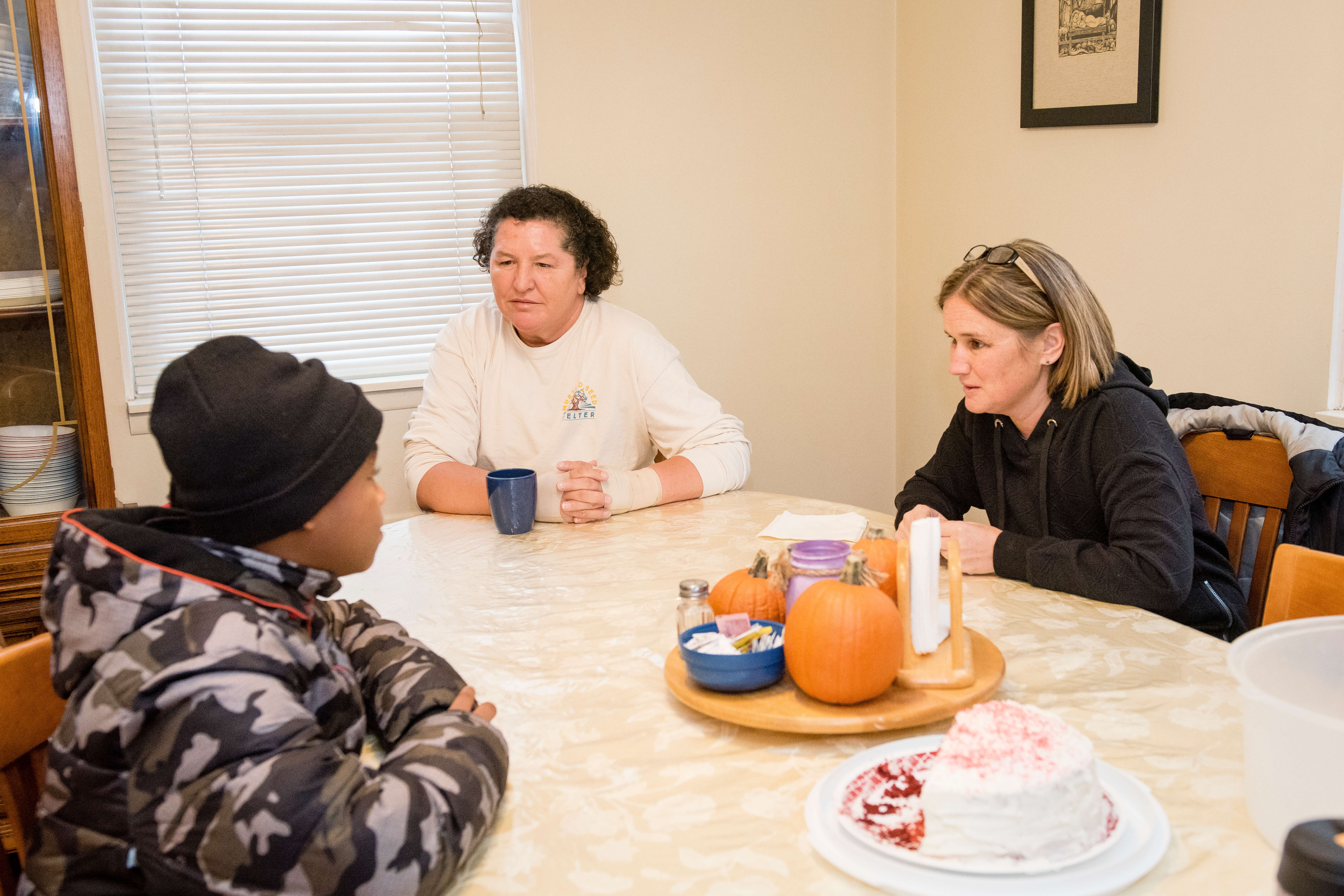
The dining room
After the stories, it’s time to see the rest of the house. As you walk through the clean sunny kitchen, you notice Irene turning sizzling sausages in a large pan while other pots boil away on the stove. On the counter is a mixer, and under the large window that looks out on the back yard is a large stainless steel sink with surprisingly few dirty dishes, considering how many women and children live in this house.
Passing through the kitchen, you enter the dining area where two long rectangular tables with multiple chairs are placed side by side, leaving plenty of space to walk between. Small pumpkins are placed in the center of each table, as a reminder of the Thanksgiving holiday. The back table holds a covered cake plate, and one of the women walks over, lifts the cover, and cuts herself a slice of red velvet cake. Looking around this comfortable dining area, you notice how well equipped it is, with tables holding a toaster, coffee pot, dishes and serving utensils. You hear children’s voices as another woman who lives at the shelter returns home with her two children, a girl and boy. They join in conversation with the other women, but suddenly the lovely little girl exclaims that she forgot to pick up her toys in the toy room (a house rule) and rushes off. Her brother follows.
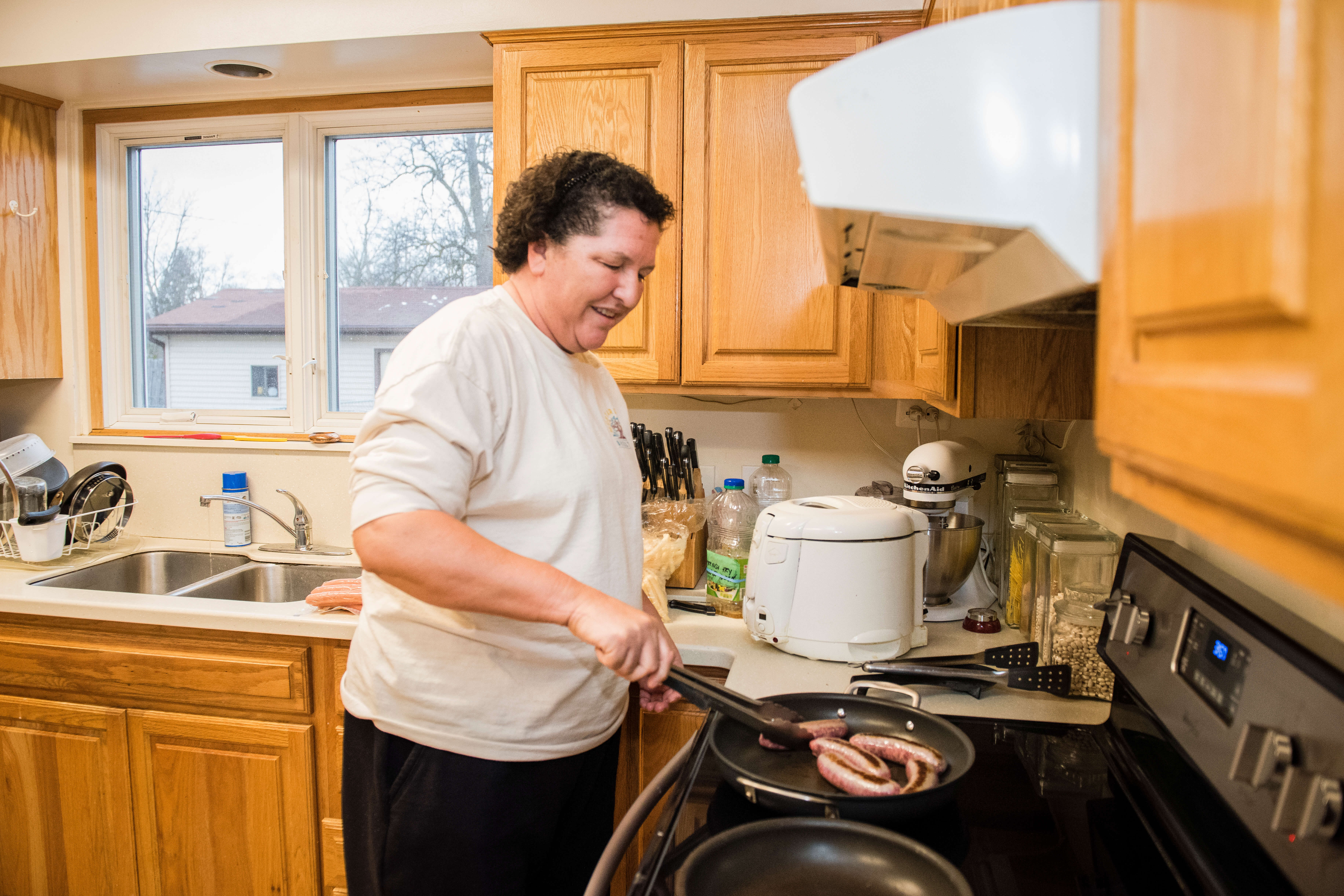
The children’s space
At this point Amy suggests a visit to the basement toy room. On the way down the stairs, she explains that a Saginaw Valley State University fraternity tore down a wall to enlarge the space, and a church group, 242, donated time and materials to make this a special place for children to play. Before we turn right to enter the play area, Amy shows us a large laundry area for the women to the left, which is equipped with a washer, dryer, and also a refrigerator for women who want to store their own food and drink supplies.
After a quick look, we turn right and enter a play area that would exceed any child’s dreams! It is a long rectangular room with beautiful wooden shelves lining the walls. On the shelves are books, puzzles, trucks, dolls, dress-up clothes, and more. The back corner holds two blue bean bags, with a young boy stretched out, relaxing, in one of them. The entire floor is covered with soft foam play squares, so you step silently and comfortably around the brightly painted room. At the other end is the little girl cradling her doll. She has obviously picked up all her toys now, as everything is neat and tidy in the little kitchen area with play sink, stove, cupboards, and dishes. She talks quietly as she places her baby in a tiny high chair. This play room, she says, is her favorite place in the house! “God bless the church volunteers who built the shelves, installed the flooring, and transformed this into a children’s wonderland!” you think, as you follow Amy upstairs to the second floor to see where the women and children sleep.
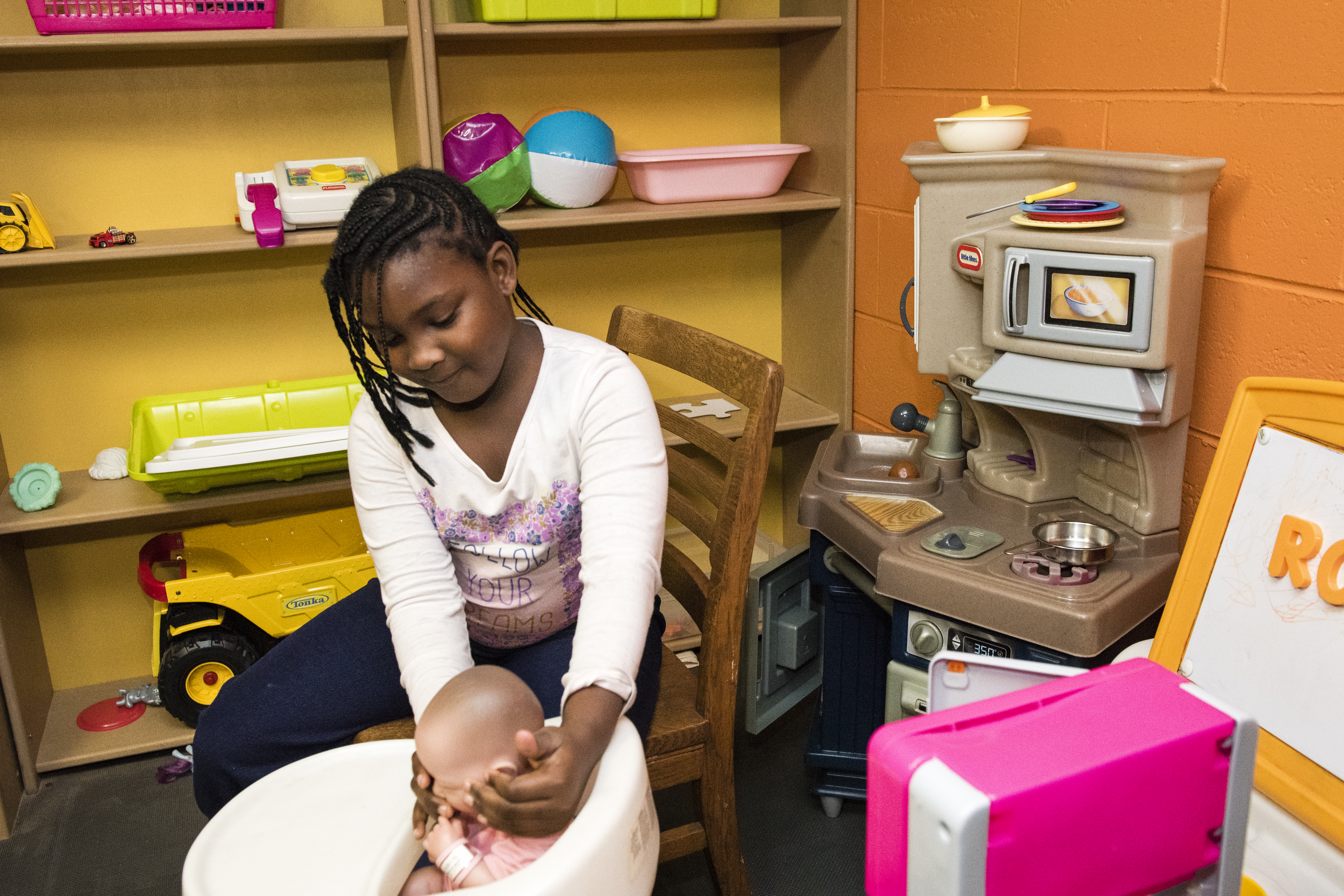
The living quarters
Reaching the top floor, you see a long hallway with a baby changing table at the far end, under a small window. Every bit of storage area in the hallway holds the women’s personal possessions. Amy leads us into a room on the left, explaining that what were once large bedrooms with connected sitting rooms have now been converted into rooms where a mother can occupy one room and have her children sleep in the adjoining room. The family shares a bathroom.
To the right of the landing is the space for single women. Entering the first bedroom, you see 3 beds lined up and multiple dressers along the walls. Other rooms are across the hall. While everything is clean and neat in this upstairs living/sleeping area, space is tight. Amy tells us if there is one thing that is difficult, it is for the single women and the mothers with children to be in such close quarters. At any given time, up to 8 women and a few children are living in the house.
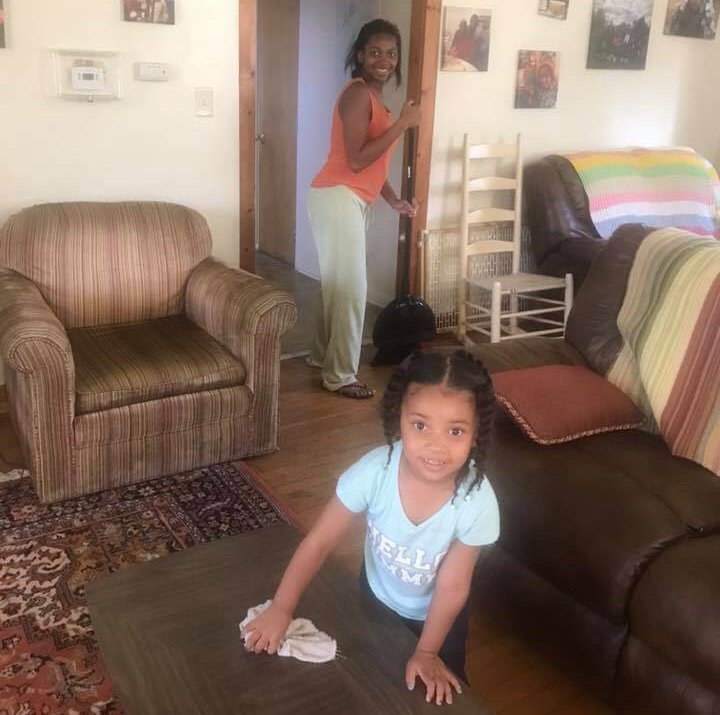
The capital campaign
Descending the stairs, Amy explains that Mustard Seed does not receive government funding, as it is not in the women’s best interests to have to adhere to government regulations and timetables. Instead, it is supported by community foundations, such as the Catholic Community Foundation of Mid-Michigan, churches, businesses, and individuals. Amy excitedly adds that Mustard Seed is currently engaged in a fundraising drive to add an addition to the home, which would allow the single women to live in one section and the mothers with children in another. This capital expansion campaign is entitled “Extend the Branch,” to symbolize the growth of this vital Saginaw shelter for women and children.
Heading up the Mustard Seed capital campaign are Patty Shaheen, Jeanne Murphy-Causley, and Nancy Martin. Already, extended Mustard Seed family members/friends in the community are stepping in to help: Chip Hendrick, of Hendrick Construction, is serving as general contractor, free of charge; Mike Finelli’s Delta College construction class framed the walls for the addition; Mike’s Wrecker transported the walls to a storage area; and a local lumber company, Builders First Source, provided a partial in-kind donation for building materials, knocking down the cost dramatically.
Amy concludes the tour by adding that the best part of her day is walking with the women day by day. The worst part is not having enough space and too many calls. She hates to turn women away. With the new Mustard Seed addition breaking ground in 2019, Amy and her staff’s days will be much better. They can extend the branch, allowing more women who want to rebuild their lives to join the Mustard Seed family. Truly, there’s no place like home for those who find both home and family at Mustard Seed.
